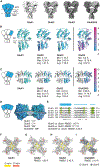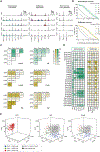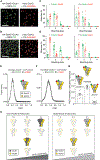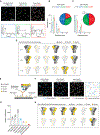Structural and compositional diversity in the kainate receptor family
- PMID: 34706237
- PMCID: PMC8581553
- DOI: 10.1016/j.celrep.2021.109891
Structural and compositional diversity in the kainate receptor family
Abstract
The kainate receptors (KARs) are members of the ionotropic glutamate receptor family and assemble into tetramers from a pool of five subunit types (GluK1-5). Each subunit confers distinct functional properties to a receptor, but the compositional and stoichiometric diversity of KAR tetramers is not well understood. To address this, we first solve the structure of the GluK1 homomer, which enables a systematic assessment of structural compatibility among KAR subunits. Next, we analyze single-cell RNA sequencing data, which reveal extreme diversity in the combinations of two or more KAR subunits co-expressed within the same cell. We then investigate the composition of individual receptor complexes using single-molecule fluorescence techniques and find that di-heteromers assembled from GluK1, GluK2, or GluK3 can form with all possible stoichiometries, while GluK1/K5, GluK2/K5, and GluK3/K5 can form 3:1 or 2:2 complexes. Finally, using three-color single-molecule imaging, we discover that KARs can form tri- and tetra-heteromers.
Keywords: cryo-electron microscopy; iGluRs; kainate receptors; single-cell RNA sequencing; single-molecule Förster resonance energy transfer; single-molecule pull-down.
Copyright © 2021 The Author(s). Published by Elsevier Inc. All rights reserved.
Conflict of interest statement
Declaration of interests The authors declare no competing interests.
Figures





Similar articles
-
Assembly and Trafficking of Homomeric and Heteromeric Kainate Receptors with Impaired Ligand Binding Sites.Neurochem Res. 2019 Mar;44(3):585-599. doi: 10.1007/s11064-018-2654-0. Epub 2018 Oct 9. Neurochem Res. 2019. PMID: 30302614 Free PMC article.
-
Determination of kainate receptor subunit ratios in mouse brain using novel chimeric protein standards.J Neurochem. 2016 Jan;136(2):295-305. doi: 10.1111/jnc.13384. Epub 2015 Oct 30. J Neurochem. 2016. PMID: 26448475
-
Mapping the ligand binding sites of kainate receptors: molecular determinants of subunit-selective binding of the antagonist [3H]UBP310.Mol Pharmacol. 2010 Dec;78(6):1036-45. doi: 10.1124/mol.110.067934. Epub 2010 Sep 13. Mol Pharmacol. 2010. PMID: 20837679 Free PMC article.
-
Structure, Function, and Regulation of the Kainate Receptor.Subcell Biochem. 2022;99:317-350. doi: 10.1007/978-3-031-00793-4_10. Subcell Biochem. 2022. PMID: 36151381 Review.
-
Lessons from crystal structures of kainate receptors.Neuropharmacology. 2017 Jan;112(Pt A):16-28. doi: 10.1016/j.neuropharm.2016.05.014. Epub 2016 May 26. Neuropharmacology. 2017. PMID: 27236079 Review.
Cited by
-
Kainate Receptor Antagonists: Recent Advances and Therapeutic Perspective.Int J Mol Sci. 2023 Jan 18;24(3):1908. doi: 10.3390/ijms24031908. Int J Mol Sci. 2023. PMID: 36768227 Free PMC article. Review.
-
Two Signaling Modes Are Better than One: Flux-Independent Signaling by Ionotropic Glutamate Receptors Is Coming of Age.Biomedicines. 2024 Apr 16;12(4):880. doi: 10.3390/biomedicines12040880. Biomedicines. 2024. PMID: 38672234 Free PMC article. Review.
-
Delving into the significance of the His289Tyr single-nucleotide polymorphism in the glutamate ionotropic receptor kainate-1 (Grik1) gene of a genetically audiogenic seizure model.Front Mol Neurosci. 2024 Jan 5;16:1322750. doi: 10.3389/fnmol.2023.1322750. eCollection 2023. Front Mol Neurosci. 2024. PMID: 38249292 Free PMC article.
-
Parvalbumin interneurons gate amygdala excitability and response to chronic stress via kainate receptor-driven tonic GABAB receptor-mediated inhibition.Mol Psychiatry. 2025 Jun 28. doi: 10.1038/s41380-025-03093-y. Online ahead of print. Mol Psychiatry. 2025. PMID: 40581655
-
scMODAL: a general deep learning framework for comprehensive single-cell multi-omics data alignment with feature links.Nat Commun. 2025 May 29;16(1):4994. doi: 10.1038/s41467-025-60333-z. Nat Commun. 2025. PMID: 40442129 Free PMC article.
References
-
- Acosta-Ruiz A, Gutzeit VA, Skelly MJ, Meadows S, Lee J, Parekh P, Orr AG, Liston C, Pleil KE, Broichhagen J, and Levitz J (2020). Branched Photoswitchable Tethered Ligands Enable Ultra-efficient Optical Control and Detection of G Protein-Coupled Receptors In Vivo. Neuron 105, 446–463.e13. - PMC - PubMed
-
- Ayalon G, and Stern-Bach Y (2001). Functional assembly of AMPA and kainate receptors is mediated by several discrete protein-protein interactions. Neuron 31, 103–113. - PubMed
-
- Birke R, Ast J, Roosen DA, Mathes B, Roßmann K, Huhn C, Jones B, Lehmann M, Haucke V, Hodson DJ, et al. (2021). Sulfonated rhodamines as impermeable labelling substrates for cell surface protein visualization. bioRxiv. 10.1101/2021.03.16.435698. - DOI
Publication types
MeSH terms
Substances
Grants and funding
LinkOut - more resources
Full Text Sources
Research Materials
Miscellaneous

